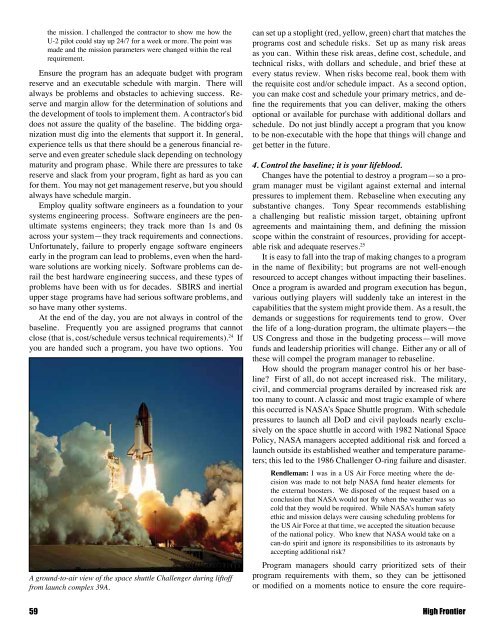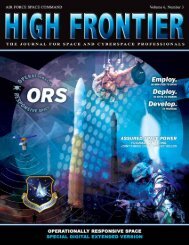Space Acquisition - Air Force Space Command
Space Acquisition - Air Force Space Command
Space Acquisition - Air Force Space Command
You also want an ePaper? Increase the reach of your titles
YUMPU automatically turns print PDFs into web optimized ePapers that Google loves.
the mission. I challenged the contractor to show me how the<br />
U-2 pilot could stay up 24/7 for a week or more. The point was<br />
made and the mission parameters were changed within the real<br />
requirement.<br />
Ensure the program has an adequate budget with program<br />
reserve and an executable schedule with margin. There will<br />
always be problems and obstacles to achieving success. Reserve<br />
and margin allow for the determination of solutions and<br />
the development of tools to implement them. A contractor's bid<br />
does not assure the quality of the baseline. The bidding organization<br />
must dig into the elements that support it. In general,<br />
experience tells us that there should be a generous financial reserve<br />
and even greater schedule slack depending on technology<br />
maturity and program phase. While there are pressures to take<br />
reserve and slack from your program, fight as hard as you can<br />
for them. You may not get management reserve, but you should<br />
always have schedule margin.<br />
Employ quality software engineers as a foundation to your<br />
systems engineering process. Software engineers are the penultimate<br />
systems engineers; they track more than 1s and 0s<br />
across your system—they track requirements and connections.<br />
Unfortunately, failure to properly engage software engineers<br />
early in the program can lead to problems, even when the hardware<br />
solutions are working nicely. Software problems can derail<br />
the best hardware engineering success, and these types of<br />
problems have been with us for decades. SBIRS and inertial<br />
upper stage programs have had serious software problems, and<br />
so have many other systems.<br />
At the end of the day, you are not always in control of the<br />
baseline. Frequently you are assigned programs that cannot<br />
close (that is, cost/schedule versus technical requirements). 24 If<br />
you are handed such a program, you have two options. You<br />
A ground-to-air view of the space shuttle Challenger during liftoff<br />
from launch complex 39A.<br />
can set up a stoplight (red, yellow, green) chart that matches the<br />
programs cost and schedule risks. Set up as many risk areas<br />
as you can. Within these risk areas, define cost, schedule, and<br />
technical risks, with dollars and schedule, and brief these at<br />
every status review. When risks become real, book them with<br />
the requisite cost and/or schedule impact. As a second option,<br />
you can make cost and schedule your primary metrics, and define<br />
the requirements that you can deliver, making the others<br />
optional or available for purchase with additional dollars and<br />
schedule. Do not just blindly accept a program that you know<br />
to be non-executable with the hope that things will change and<br />
get better in the future.<br />
4. Control the baseline; it is your lifeblood.<br />
Changes have the potential to destroy a program—so a program<br />
manager must be vigilant against external and internal<br />
pressures to implement them. Rebaseline when executing any<br />
substantive changes. Tony Spear recommends establishing<br />
a challenging but realistic mission target, obtaining upfront<br />
agreements and maintaining them, and defining the mission<br />
scope within the constraint of resources, providing for acceptable<br />
risk and adequate reserves. 25<br />
It is easy to fall into the trap of making changes to a program<br />
in the name of flexibility; but programs are not well-enough<br />
resourced to accept changes without impacting their baselines.<br />
Once a program is awarded and program execution has begun,<br />
various outlying players will suddenly take an interest in the<br />
capabilities that the system might provide them. As a result, the<br />
demands or suggestions for requirements tend to grow. Over<br />
the life of a long-duration program, the ultimate players—the<br />
US Congress and those in the budgeting process—will move<br />
funds and leadership priorities will change. Either any or all of<br />
these will compel the program manager to rebaseline.<br />
How should the program manager control his or her baseline<br />
First of all, do not accept increased risk. The military,<br />
civil, and commercial programs derailed by increased risk are<br />
too many to count. A classic and most tragic example of where<br />
this occurred is NASA’s <strong>Space</strong> Shuttle program. With schedule<br />
pressures to launch all DoD and civil payloads nearly exclusively<br />
on the space shuttle in accord with 1982 National <strong>Space</strong><br />
Policy, NASA managers accepted additional risk and forced a<br />
launch outside its established weather and temperature parameters;<br />
this led to the 1986 Challenger O-ring failure and disaster.<br />
Rendleman: I was in a US <strong>Air</strong> <strong>Force</strong> meeting where the decision<br />
was made to not help NASA fund heater elements for<br />
the external boosters. We disposed of the request based on a<br />
conclusion that NASA would not fly when the weather was so<br />
cold that they would be required. While NASA’s human safety<br />
ethic and mission delays were causing scheduling problems for<br />
the US <strong>Air</strong> <strong>Force</strong> at that time, we accepted the situation because<br />
of the national policy. Who knew that NASA would take on a<br />
can-do spirit and ignore its responsibilities to its astronauts by<br />
accepting additional risk<br />
Program managers should carry prioritized sets of their<br />
program requirements with them, so they can be jettisoned<br />
or modified on a moments notice to ensure the core require-<br />
59 High Frontier











